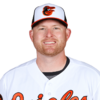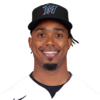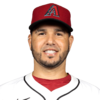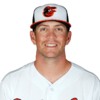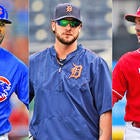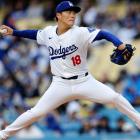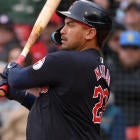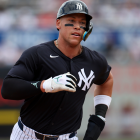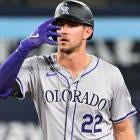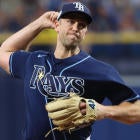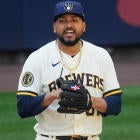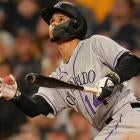Note: Don't whiff on this special FanDuel offer. Win your first contest or get your money back (up to $10) to keep playing. Try FanDuel now!
The early season MLB leaderboard is always fun. Manny Machado leading the American League with a .380 batting average makes total sense; he's one of the handful of best players in baseball. Bryce Harper's MLB-leading nine homers always totally fit in with what our expectations were coming into the season.
But Colby Rasmus leading the AL in homers? Daniel Murphy leading the way in average, following closely by Dexter Fowler? I'm not sure anyone really could have seen that coming.
Sure, you could see Colby Rasmus getting hot for a month and hitting seven homers, but it's still jarring to see him sitting at the top of the heap for an entire league. That's the thing about early season results; just because they come first, doesn't mean they are inherently important or meaningful. A hot streak in April isn't any more relevant than one in May or August or any other month.
With this in mind, I decided to look at the top players at each position to see who doesn't belong. And to try to figure out whether they might before long.
Catcher - Jarrod Saltalamacchia, Detroit Tigers (No. 1)
Historically, if you could keep Saltalamacchia from seeing too many left-handed pitchers, he could be a pretty productive hitter at the catcher position. Saltalamacchia broke out in his final three seasons in Boston, largely on the strength of his hitting against right-handed pitching:
2011-2013, vs. RHP: 988 PA, .256/.319/.495; 7.9 BB%, 31.0 K%, .239 ISO
2011-2013, vs. LHP: 316 PA, .206/.272/.338; 8.2 BB%, 28.5 K%, .132 ISO
Saltalamacchia, a switch hitter, had contact issues form either side of the plate, but at least made up for it as a lefty with major power. And the Red Sox smartly had 75.8 percent of his plate appearances come with the platoon split he could actually take advantage of. The Tigers are splitting his playing time similarly, and seeing great results as a result. He won't be able to keep anything like this kind of pace up, obviously, but it is no coincidence that most of his production has come against right-handed pitching so far. If they continue using him primarily as a lefty, he can continue to be a solid source of power at the catcher position; that's not nothing.
First Base - Mark Trumbo, Orioles (No. 1)
Trumbo is off to an outrageous start, but it's not totally out of nowhere. In his first 17 starts last season, Trumbo hit .324/.343/.559, and he had another stretch from late April to mid-May where he clubbed five homers while hitting .300 in 17 starts, so he is capable of these kinds of runs. The problem is, he typically doesn't sustain them; he followed up that mid-May run by hitting just .206/.270/.397 in his next 18 games, and hit just .254/.308/.415 from May 13 on last season. He'll always be a solid source of power, and playing in this Orioles' offense could help Trumbo get back to the high-90's in RBI for the first time since 2013, but Trumbo is an extremely streaky hitter, so this isn't necessarily anything new.
Second Base - Jean Segura, Diamondbacks (No. 3)
The biggest difference for Segura so far is the power; his .188 ISO is exactly double his career mark, and a major outlier. Beyond that, he is simply getting a bit of good luck on batted balls, with a .352 BABIP, a number that will likely come down. Segura does a solid job of avoiding strikeouts, but typically struggled to hit for much average because he doesn't put balls over the fence or hit them hard enough (22.8 percent career hard-hit average; 20.3 percent this season) to sustain a high BABIP. This fast start has been nice, and you should expect him to run more often moving forward, but he is a definite sell-high candidate if you can pull it off.
Third Base - Eugenio Suarez, Reds (No. 4)
Unlike some of the other names on this list, it's not clear if what Suarez is doing is wholly unsustainable. He won't hit .300 with an OPS nearing .900 for a whole season, obviously, but what Suarez is doing so far this season looks a lot like what he did last season. He's doing everything better, sure, but the basic shape of his profile is basically the same. He's shaved a few points off his strikeout rate and added a few more to his walk rate, and is hitting for more power overall, but he doesn't have a terribly unsustainable BABIP, for one. Suarez's HR/FB rate of 23.8 percent isn't sustainable, but he has bumped his hard-hit rate and pull rate, so a power boost isn't totally out of the question. Suarez will slow down, but overall he mostly just looks like a better version of the player he was last season; for a 24-year-old, that's not out of the question.
Shortstop - Aledmys Diaz, Cardinals (No. 3)
It's going to be very interesting to see what the Cardinals do when Ruben Tejada and Jhonny Peralta are both healthy, because Diaz has given them no reason to think they need to make a change at the shortstop position. Diaz has been red hot to start his major-league career, and there is actually a lot to like about his minor-league track record, too; Diaz showed decent pop in Double-A last season, while cutting his strikeout rate to 15.2 percent. He is seeing the ball extremely well this season, with just three strikeouts in 53 plate appearances, and has shown enough pop in the majors and minors to get at least a little bit excited about for a middle infielder. He may not have an everyday role all season, but there's also a chance he never really gives Tejada and Peralta a chance to take it from him.
Outfield - Dexter Fowler, Cubs (No. 2); Colby Rasmus, Astros (No. 4 ); Wil Myers, Padres (No. 12)
On the one hand, Fowler's .478 BABIP screams "REGRESSION" in big, bold red letters. On the other hand, I'm not sure he's a sell-high candidate. Sure, he's not going to keep hitting .385 -- that goes without saying. However, Fowler is walking a ton, running the bases well and hitting for power, three things he has shown he can definitely do. Last season, for instance, he posted a .346 OBP with 17 homers and 20 steals, despite hitting just .250. He might hit .285 instead of .385 from this point on, but with his secondary skills in that lineup, Fowler is going to be a strong starting outfield option all season long. You shouldn't be looking to trade him just because his BABIP is through the roof, in other words.
Like Saltalamacchia, Rasmus has always benefited from avoiding left-handed pitchers. The gap isn't quite as big for him as Salty, but it is there, and has been an impediment to him being an everyday player over the past few years. The Astros have done a great job of putting him in the best situation to succeed so far, with just 12.0 percent of his plate appearances coming against lefties. Rasmus is absolutely crushing the ball, with a hard-hit rate of 47.6 percent, a good combination with his flyball-heavy approach. The interesting thing to keep in mind is that Rasmus was actually better against lefties last season, which would be a very interesting late-career change. However, this is a guy who hit 20-plus homers in four of the last six seasons, and is absolutely a must-own player with the way he's swinging the bat right now, even if I would look to sell high on him if I could.
Like Rasmus, Myers is a former top prospect who may be blooming, though the evidence is a bit less compelling in his case. Myers is hot right now, racking up two homers and 16 hits during a nine-game hitting streak, but is still showing plenty of flaws in his game. Myers' plate discipline has fallen apart (four walks, 25 strikeouts in 76 PA), and much of his apparent improvement is tied to a .408 BABIP. The power improvement may be real if he can sustain the increased flyball and hard-hit rates, but if he can't start avoiding strikeouts, it may not matter.









